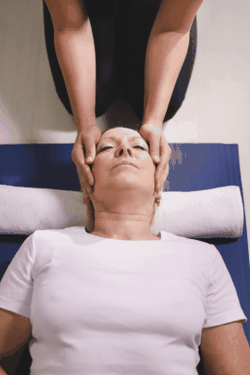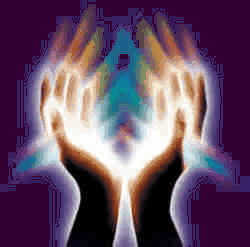Reiki is an alternative form of healing therapy quickly becoming popular in the West. Reiki involves the soothing and comforting touch of the human hand is emphasized as having wonderful wellness benefits due the transference or increasing ‘universal energy’ within the human body. In Reiki, the human touch is regarded as essential in the transference of energy. The concept of ‘chi’ or ‘ki’, which is a ‘universal energy’ that flows through all things is central to Eastern philosophy. Originating in the East, Reiki is the latest in alternative and complementary approaches to health, wellbeing and wellness along with acupuncture, acupressure, yoga and, of course, meditation.
The history of Reiki begins in Japan where Mikao Usui (1865-1926), a Buddhist priest and martial artist. In pursuing his spiritual path, he climbed Mount Kurama and once at the top, he meditated for 21 days.  During this time, Mikao experienced a sense of enlightenment and discovered a what he felt was a revolutionary, natural healing system that would become known as Reiki. The word Reiki is the combination of two Japanese characters. ‘Rei’ which translates to ‘Universal Life’ and ‘Ki’ which translates to ‘Energy’. In April, 1922 Mikao Usui moved to Tokyo and established an institute to teach and utilize his unique system of strengthening and empowering the ‘life energy’ within each individual.
During this time, Mikao experienced a sense of enlightenment and discovered a what he felt was a revolutionary, natural healing system that would become known as Reiki. The word Reiki is the combination of two Japanese characters. ‘Rei’ which translates to ‘Universal Life’ and ‘Ki’ which translates to ‘Energy’. In April, 1922 Mikao Usui moved to Tokyo and established an institute to teach and utilize his unique system of strengthening and empowering the ‘life energy’ within each individual.
Mikao Usui’s approach was to provide each client/practitioner with the tools necessary to practice Reiki on their own. Practitioners of Reiki in today’s world might be curious to discover that experts believe Mikao adapted his approach for each person. There is probably not, therefore, a ‘one true system’ of Reiki, but rather a collection of approaches that can be utilized, depending on what an individual needs. All Reiki systems, however, hold that ‘life energy’ is the key to health. Much like yoga and meditation, there are many different forms of Reiki and no one way is considered to be the one right mode of practice. The right mode of practice is what works for the client and practitioner.
By the time Mikao died in 1926, he had taught his system of Reiki to thousands of people. A Usui memorial was created at the Saihoji temple in Tokyo in 1927. Part of an inscription gives 5 admonitions:
1. Do not get angry today.
2. Do not be grievous.
3. Express your thanks.
4. Be diligent in your business.
5. Be kind to others.
These are often referred to as the five precepts of Reiki in order for practitioners to lead happier more fulfilling lives.
After Mikao Usui’s death some of his students with a more advanced understanding of Reiki began teaching. One of these students was Chujiro Hayashi, a doctor of medicine. He further developed Reiki, incorporating his medical and anatomical knowledge of the body into the system.
Another student, Hawayo Takata is famous for bringing the Eastern tradition of Reiki to the West. Hawayo had health troubles, but believed that there must be another form of healing, outside of the traditional medical model. She sought treatment from a Reiki practitioner and within six months, found she had regained her health. Hawayo Takata studied the Reiki system in Japan and eventually brought it to the United States. Like Mikao, Hawayo also varied her approach to teaching Reiki for each individual student. Unfortunately, Hawayo, in her zeal for Reiki, wanted to ‘repackage’ Reiki for Westerners and misstated a number of facts about Mikao Usui and created some controversy in her claims about Reiki. Though Hawayo Takata’a aim might have be a good one, to make Reiki more acceptable and interesting to Westerners, her effort backfired and somewhat tainted Reiki’s general reputation. None the less, Reiki’s appeal and growing fans seem to attest to Reiki’s value as a complimentary wellness approach.
As Reiki gained wider practice in the West, it lived on quietly in Japan until 1985 when interest and teachings picked up again. Today there is a distinction between two primary classes of Reiki: Japanese Reiki and Western Reiki. Japanese Reiki has more or less stayed true to Mikao Usui’s approach as a result of Mikao’s first students passing down teacher-to-student certain Reiki practices. In the West, Reiki adapted and evolved to incorporate concepts and techniques compatible to ‘life energy’ philosophy. One could say that, as of the writing of this article, Western Reiki and Japanese Reiki are in the process of getting to know one another again. Western Reiki masters and students traveling to Japan to study, and Japanese Reiki masters and students traveling to the West to do the same.
As Reiki has developed through time, it has been taught and practiced by hundreds of thousands of people. Reiki is more popular today in North America and Japan than it ever has been.
There are two broad branches of Reiki, but many more varieties with something for everyone. Mikao and Hawayo, the two most famous Reiki masters, made a point of varying the method to suit the individual. Practitioners believe Reiki belongs to everyone who wants to practice it.Psychic Genevieve is Reiki Master and clairvoyant. If you are looking for someone to talk with about energy readings (or anything else) give Janice a call at 1-866-407-7164. If you are interested in Reiki, perhaps in a basic course or to become a Reiki master yourself, check out this Reiki Course.

